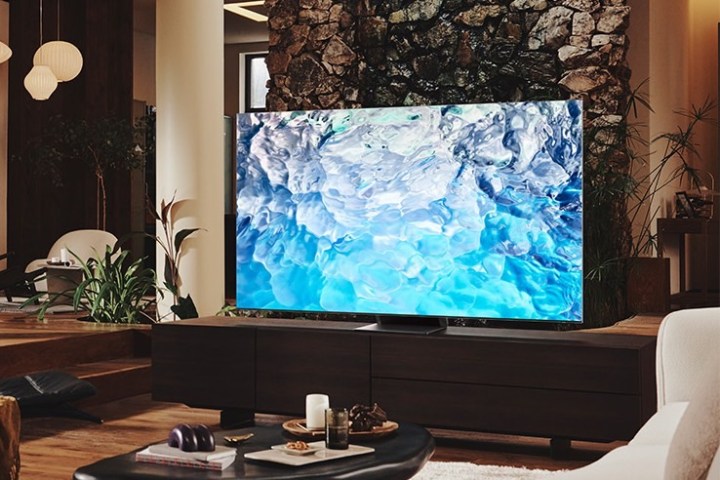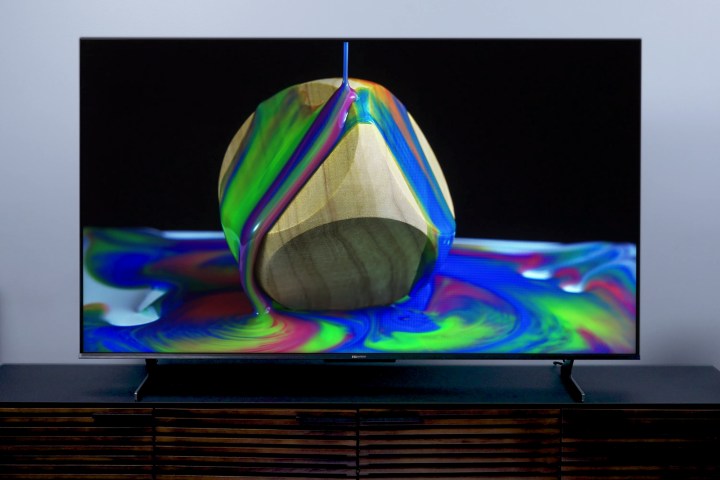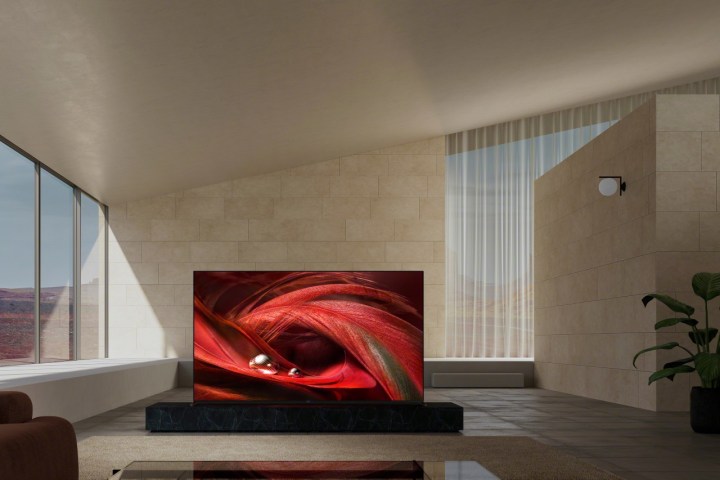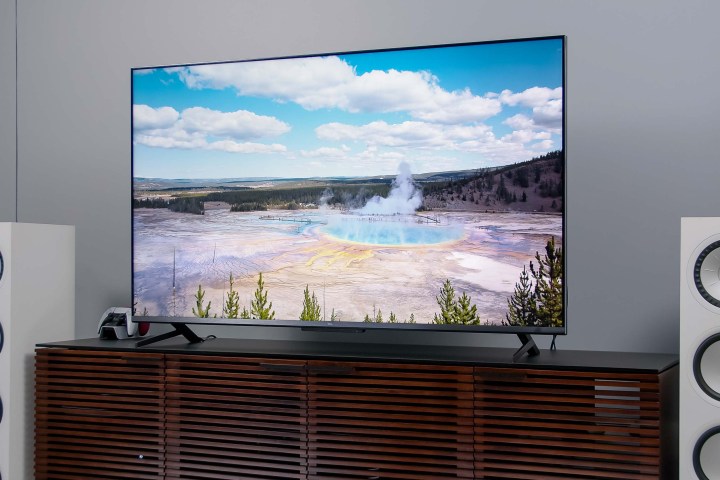When LED TVs hit shelves over 10 years ago, consumers were beyond elated. Never before had we seen such arresting levels of brightness on our TVs, making everything from regular cable channels to Blu-ray discs look and feel all the more vibrant. But like all things AV-related, the introduction of LED lighting was only the beginning. Nowadays, one of the two biggest draws when it comes to TVs is the almighty “QLED” moniker (the other is OLED).
“QLED” refers to something called quantum dots, a layer of charged particles that emit incredible amounts of colored light when energy is passed through them. A staple of Samsung TVs, QLED sets can now be found from brands like TCL, Hisense, and Vizio, too.
If you like your TV to be bold in every way, a QLED set is a fantastic choice for picture tech, but with so many options out there, it can be tough to choose the right set for your home. That’s why we’ve gone ahead and created this roundup of the best QLED TVs for 2022.

65-inch Samsung QN90B
The best QLED TV
Pros
- Powerful brightness and rich colors
- Four HDMI 2.1 inputs
- Excellent gaming features
- Sleek and intuitive smart TV interface
Cons
- Some issues with light blooming
- No Dolby Vision support
Why you should buy it: Samsung’s QN90B delivers one of the most vibrant and colorful pictures of any QLED on the market, and the black levels are pretty amazing, too.
Who it’s for: Those of us that cannot part ways with the arresting brightness of a QLED screen, but want to dip our toes into OLED waters, too.
Why we chose the Samsung QN90B:
Samsung has been the undisputed champion of QLED technology for several years now, and if you’re looking for one of the best QLEDs that money can buy, look no further than the amazing QN90B.
Available in several sizes (from 43 inches to 85 inches), the muscle behind the QN90B’s incredible visuals goes to Samsung’s Neo Quantum Processor 4K and Quantum Matrix Technology, a combination of clarity and contrast picture engines that deliver chart-topping peak brightness levels and stellar color brightness, too. And while the QN90B does a great job at making all sources look great, it’s HDR-viewing (the QN90B supports HDR10, HDR10+, and HLG formats) that truly puts the TV over the edge.
Do keep in mind that because we’re dealing with mini-LED lighting here, light blooming can be a little bit of an issue during significantly dark scenes in movies and shows, a minor blip in an otherwise perfect picture.
The QN90B is also a solid TV for those of us looking to future-proof our AV systems. With all four HDMI inputs (each capable of 4K/120Hz) classed as 2.1 ports, you’ll be able to wire up all your go-to streaming devices and next-gen gaming consoles for years to come. The QN90B also includes a number of gaming must-haves, including NVIDIA G-Sync, AMD Free-Sync, and Variable Refresh Rate (VRR) support.
In terms of sound, thanks to HDMI eARC, Dolby Atmos enthusiasts will be able to use the QN90B as a gateway to one of the most immersive surround sound codecs available. And if you’re not using an AV receiver or soundbar to experience your audio, the QN90B’s Object Tracking Sound+ does a decent job at creating a balanced and believable soundstage right from the TV speakers.
Behind the scenes, Samsung’s calling card Tizen OS is the brains behind the user interface and the QN90B’s smart TV features, allowing access to an immense library of apps, games, and screen mirroring options for mobile devices.
Visually stunning and feature-rich, the Samsung QN90B is our favorite QLED TV, and we’ll be singing its praises for some time.

65-inch Samsung QN90B
The best QLED TV

Samsung
65-inch Samsung QN900B
The best 8K QLED TV
Pros
- Capable of 8K resolution
- Four HDMI 2.1 inputs
- Enhanced clarity and contrast picture engines
- Great smart TV platform
Cons
- Expensive
- No Dolby Vision support
- Not practical for some viewers
Why you should buy it: You want all the same great picture tech and smart features of the Samsung QN90B, in addition to future-proofed 8K resolution.
Who it’s for: Those of us that want to experience the mind-bending beauty of 4K content upscaled to 8K standards.
Why we chose the Samsung QN900B:
In the world of consumer tech, hardware often arrives at the party far earlier than software and content. And in the case of the Samsung QN900B, the early bird is the TV’s 8K panel.
As of yet, 8K resolution is a picture standard we’re still working towards. Yes, you can find some 8K videos on YouTube and Vimeo, but that’s about it for now. That being said, the QN900B is going to look amazing, no matter the source you’re pumping into it. In fact, you can think of this set as an elevated version of the QN90B.
With the QN900B, you’re getting everything that makes the QN90B a phenomenal set, from four HDMI 2.1 inputs to stand-out gaming features and HDR support, but with a little extra push in the clarity and upscaling departments, thanks to Samsung’s Neural Quantum Processor 8K and Quantum Matrix Tech Pro.
The QN900B also touts Samsung’s Infinity Screen, a near bezel-less design that accentuates just how gripping the picture actually is. At around $3,500 for the 65-inch (also available in 75- and 85-inch sizes), the QN900B may not be the QLED for everyone, but when it comes to 8K, we can’t think of a better choice.

65-inch Samsung QN900B
The best 8K QLED TV

Zeke Jones/Digital Trends
55-inch Hisense U8H
The best QLED for brightness
Pros
- Intensely bright
- Class-leading black levels
- Impressive HDR imaging
- Vibrant, accurate Color
- Surprisingly Good Sound
Cons
- Quirky user interface
- Some bugs
Why you should buy it: You’re not into dropping thousands of dollars for a flagship TV, but still want a high-performance set from a trusted name.
Who it’s for: Those looking to get their hands on a great QLED TV for a great price.
Why we chose the Hisense U8H:
Hisense continues to chart its course as one of the best TV brands in the world of TVs, and with the release of the mini-LED powered U8H, the company has set the bar high for its budget brand competitors.
Simply put, it’s hard to beat the kind of brightness, colors, contrast, and motion that the U8H is capable of, and even when compared to some of the best TVs from the likes of Samsung, Sony, and LG, the U8H still delivers some of the highest numbers we’ve seen in a QLED. We’re talking close to 2,000 nits for specular highlights in HDR, with a sustained output of around 1,500 nits. Believe us, that’s pretty astonishing.
Out of the box, we did have a few qualms with some of the default picture settings, and while the Google TV user interface is fairly easy to navigate and customize, we found it difficult to use when trying to access some of the TV’s basic picture settings. But when you consider the TV’s two HDMI 2.1 inputs, 120Hz refresh rate, and VRR and Free-Sync Premium support, it’s almost like the value never ends.

55-inch Hisense U8H
The best QLED for brightness

Dan Baker/Digital Trends
55-inch Sony Bravia X95K
The best QLED for videophiles
Pros
- Rich, vibrant color
- Vivid HDR highlights
- Superior highlight and shadow detail
- Excellent Sound
Cons
- Some slight blooming/halo
- VRR disables local dimming
Why you should buy it: Sony has long been the undisputed champ of LCD-LED picture realism, and the company’s X95K is another notch in the lifelike-accuracy belt.
Who it’s for: Those of us that want the most immersive TV picture we can get our eyes on.
Why we picked the Sony Bravia X95K:
If you’re looking for Sony’s best picture, and don’t want to invest in the expensive but stunning QD-OLED A95K, the X95K QLED is a second-best that looks and feels like a lot like its much more expensive older brother.
Incredible color accuracy and saturation is the name of the game here, with the X95K capable of delivering some very lifelike visuals, one of Sony’s many calling cards over the last decade or so. And with its incredible mini-LED backlighting and whip-fast dimming zones, the X95K punches high above its weight. You’re also working with four HDMI inputs (4K/120Hz), one of which features eARC support for all our Dolby Atmos diehards out there.
Even from a sound perspective, the X95K achieves a much bigger and more balanced sense of soundstaging than last year’s X95J model. Of course, no TV can deliver the full gravitas of a soundbar or dedicated surround-sound system.
Off-angle viewing with the X95K is okay, although some color highlights and overall contrast tend to take a hit, but this is rather par for the course when it comes to any kind of LED-powered set. And seeing as this is a Sony, the user interface and smart TV features are powered by Google TV, a quick and intuitive platform that connects you with all your favorite streaming apps and even allows you to mirror content from your phone to the X95K.
Whether you’re a first-time Sony buyer or a returning fan, the X95K is one of the best-looking QLEDs we’ve laid eyes on this year.

55-inch Sony Bravia X95K
The best QLED for videophiles

Sony
65-inch Sony Bravia X95J
Another great Sony QLED
Pros
- Stunning brightness and colors
- Four HDMI 2.1 inputs
- Incredible HDR support
- Smooth and responsive Google TV interface
Cons
- A little difficult to find
Why you should buy it: Sony’s image processing is second to none, and this is one of the company’s best 4K QLED TVs.
Who it’s for: Anyone who puts a priority on picture quality above all else.
Why we picked the Sony Bravia XR X95J:
It doesn’t seem to matter whether we’re watching Sony’s latest OLED or QLED models, they just keep nailing picture processing. And such is the case, yet again, with the almighty Sony Bravia X95J.
Chief amongst the set’s picture technologies is something called Cognitive Processor XR Pro. The engine employs artificial intelligence to adjust the way images appear on the screen. Instead of treating the entire image as a single entity, Cognitive Processor XR purports to analyze all of the different elements that make up the image, treating each as its own object — much the way our brains do.
Pair this new image-processing tech with support for HDR10, HLG, Dolby Vision, IMAX Enhanced, and Netflix Calibrated modes, and it’s clear why the X95J is a cineaste’s dream come true.
But there’s more to the X95J than just image quality — way more, in fact. Sony has thrown in the full HDMI 2.1 spec, complete with HDMI eARC, VRR (following a software update), ALLM, and 4K video at 120Hz. There’s also support for the Apple TV app, Apple AirPlay 2, Apple HomeKit, and Chromecast. With far-field microphones, you can do hands-free voice commands with Google Assistant, or with the TV’s own built-in search system.
Sound is also a strong point thanks to Sony’s Acoustic Multi-Audio — which embeds multiple speakers into the TV’s frame — and its ability to virtualize Dolby Atmos, giving a simulated sense of width and height to surround sound movies and shows.

65-inch Sony Bravia X95J
Another great Sony QLED

Riley Young
75-inch TCL 6-Series (R655)
The best big-screen QLED
Pros
- Punchy HDR brightness and color
- Minimal backlight blooming
- Good motion resolution
- Great viewing angles
- Intuitive Roku interface
Cons
- Requires adjustment for best picture
- Struggles to clean up low-quality content
Why you should buy it: When it’s a large screen that you’re seeking, the 75-inch TCL 6-Series is an excellent option, especially if you’re looking to save a few bucks.
Who it’s for: Fans of the Roku TV OS and TCL — a match made in heaven for those of us that tend to go toward budget TV purchases.
Why we chose the TCL 6-Series:
A solid foe to the Hisense U8H, the all-new TCL 6-Series is available in three different sizes — 55-, 65-, and 75-inch options — but it’s the latter that truly catches our attention. Simply put, if you’re looking for a large screen, this is a surefire contender.
Powered by the Roku TV OS for all things smart TV and user interface-oriented, those familiar with the look and feel of Roku’s platform will feel right at home, with a minimal learning curve for first-time users. You’ll have access to a number of popular apps (billed as Streaming Channels), from Netflix to Disney+, with the ability to mirror content from your mobile devices, too.
And in terms of picture quality, the TCL 6-Series rocks a mini-LED powered 4K screen, complete with four HDMI inputs, a 120Hz refresh rate, and excellent gaming perks, too (including VRR and AMD Free-Sync Premium Pro support). It’s not the brightest or most colorful set we’ve ever laid our eyes on, but the TCL 6-Series delivers the kind of image that most viewers will be glad to write home about.

75-inch TCL 6-Series (R655)
The best big-screen QLED

65-inch TCL 6-Series (R646)
The best budget QLED TV
Pros
- Bright, vivid picture with deep blacks
- Very good color accuracy
- Zippy mini-LED backlight control
- 4K 120Hz capable for gaming
- High value
Cons
- Glitchy operation
- No input button on remote
Why you should buy it: TCL combines the elegant Roku TV interface with QLED and mini-LED technologies at an unbeatable price.
Who it’s for: Those who want a premium TV without the premium price.
Why we picked the TCL 6-Series (2021):
Last year, TCL introduced mini-LED backlighting on the 6-Series, proving that the miniaturized light sources can make a big difference in contrast, black levels, and detail. And based on our hands-on experience with the R646, we love the end result.
Brightness soars with this TV, especially when it comes to peak nit output. The vivid visuals are present when it comes to color brightness too, making for a budget QLED that is packed with lots of punch and kick in the picture department, and for a relatively low price.
The 6-Series is also optimized for gaming, with its four HDMI inputs supporting 4K/120Hz, making this a blistering-fast choice for PS5 and Xbox Series X enthusiasts. In terms of overall picture upscaling, the 6-Series doesn’t touch the kind of cleanup powers you’ll find on higher-priced sets from Samsung and Sony, but for those of us that plan to do most of our TV-watching with Netflix and other mainline streaming apps, the TCL 6-Series (R646) is an excellent budget option.

65-inch TCL 6-Series (R646)
The best budget QLED TV
Frequently Asked Questions
UHD vs. QLED: What’s the difference?
UHD stands for ultra-high definition, also known as 4K. It’s a description of resolution, or the number of pixels that make up an on-screen image. It can refer to the resolution of a specific piece of content (many streaming services offer movies in UHD) as well as the native resolution of a TV. QLED refers to the kind of display technology a TV uses (see above). QLED TVs come in various native resolutions, from HD to 8K, including UHD.
Is QLED better than OLED?
It depends. Right now, QLED TVs are capable of getting brighter than OLED TVs, which deliver better black levels and contrast. We feel that OLED TVs still produce a better overall picture quality, but if your viewing area is especially bright, or if you want a really big screen, QLED models might be a better choice for you.
Is QLED the best TV technology?
Once again, it depends on your particular situation. For instance, if you want a TV for your patio, where it will experience partial or full sun, an OLED TV simply won’t get bright enough to compete with all that daylight, and a QLED TV is definitely superior. On the other hand, if you can darken your media room whenever you want, an OLED TV will still deliver the deepest blacks and highest contrast.
What should I look for in a QLED TV?
Finding the right QLED TV for you is all about balancing size, picture quality, features, and price. First, figure out your budget, then prioritize the rest of your list. If getting the biggest TV for your money is the top priority, you’ll be able to find 75-inch and larger models from brands like TCL, Vizio, Hisense, and LG that are still quite affordable. If picture quality matters more – especially when viewing HDR material – you should choose a model with a very high peak brightness. If gaming is a top consideration, make sure you find a model that’s equipped with VRR, ALLM, and 4K at 120Hz for the best possible experience.
Which is the best Samsung QLED TV?
Samsung has two flagship QLED models depending on whether you want 8K resolution. The QN900B is the company’s top 8K model, and the QN90B is its top 4K model.
Are QLED TVs good for gaming?
Yes, but picking the right model is key. You’ll want to look for a TV that has the latest HDMI 2.1 features, like VRR, ALLM, and 4K at 120Hz. Another feature that gamers will appreciate is support for AMD’s FreeSync or Nvidia’s G-Sync, which are two proprietary VRR technologies used by game consoles like the Xbox Series X and many gaming PCs.
Do QLED TVs have problems with burn-in?
No. Burn-in is a permanent form of image retention caused by leaving the same image on a TV for many hours at a time. In OLED TVs, this can cause individual pixels to age prematurely, leaving the “shadow” of some parts of the image on screen even after the image has changed. Because QLED TVs use a backlight for their brightness, their pixels aren’t susceptible to this kind of uneven aging.
How long do QLED TVs last?
Theoretically, a QLED TV will outlast an OLED TV, at least in terms of maximum brightness, because OLED pixels lose their ability to produce brightness at a faster rate than a QLED TV’s backlight. But you would likely have to keep your TV on for eight hours a day, seven days a week, for many, many years before this difference became noticeable. That said, a QLED TV should last a decade or more as long as none of its individual components fail — something that can be hard to predict even for the best TVs.
When will QLED prices drop?
QLED prices, much like OLED prices, are dropping all the time. A few years ago, you’d need to spend well over $2,000 for a 65-inch QLED TV. Today, you can find them for less than half that price.
Is a QLED worth it?
Definitely. If you have a choice between a standard LED TV and a QLED TV, the QLED model will deliver brighter, more accurate colors, which should yield a better image overall. And as QLED TVs become the norm for non-OLED models, you won’t have to pay much of a price premium to get one.
Editors’ Recommendations
